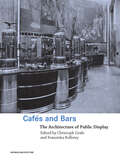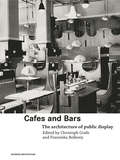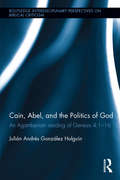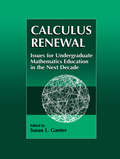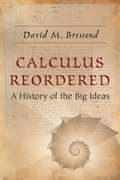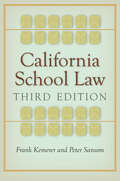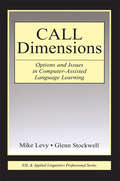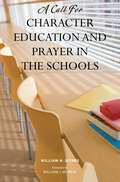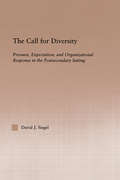- Table View
- List View
'cadjan - Kiduhu': Global Perspectives On Youth Work (PDF)
by Brian BeltonIn this book academics, practitioners and scholars from all over the planet present relatively heterogeneous perspectives to produce something of the homogenous whole that youth work might be understood to be. This promotes the understanding that to lock down youth work in notional stasis (bolt it into a ‘carceral archipelago’) would be the antithesis of practice, which would effectively destroy it as youth work. Other writers have effectively tried to achieve just this, or perhaps identified (put a flag in) what they see (or want to be) the ‘core’ of youth work practice. But youth work is not an apple. A global and historical perspective of youth work shows it to be a relentlessly developing range of responses to a persistently growing and shifting range of phenomena, issues and directions presented by and to societies and the young people in those societies. Here the authors offer a set of responses from within the incessantly metamorphosing field that can generically be called ‘youth work; they do this in this time, from many places and a diversity of identities, but they all identify what they present professionally and/or academically with what they agree to be the glorious rainbow palette that youth work is.
CAESAR AND CLEOPATRA A - History by BERNARD SHAW
by An Introduction notes by A. C. WARDAs to the other plays in this volume, the application of my title is less obvious, since neither Julius Caesar, Cleopatra,nor Lady Cicely Waynflete [in Captain Brassbound’s Conversion] have any external political connection with Puritanism. The very name of Cleopatra suggests at once a tragedy of Circe, with the horrible difference that whereas the ancient myth rightly represents Circe as turning heroes into hogs, the modern romantic convention would represent her as turning hogs into heroes. Shakespeare’s Antony and Cleopatra must needs be as intolerable to the true Puritan as it is vaguely distressing to the ordinary healthy citizen, because, after giving a faithful picture of the soldier broken down by debauchery, and the typical wanton in whose arms such men perish, Shakespeare finally strains all his huge command of rhetoric and stage pathos to give a theatrical sublimity to the wretched end of the business, and to persuade foolish spectators that the world was well lost by the twain.
The CAFE Book: Engaging All Students in Daily Literacy Assessment and Instruction
by Gail Boushey Allison BehneFor the past ten years, Gail Boushey and Allison Behne worked with hundreds of teachers and students nationwide to gain insightsinto the best practices for reading instruction. Using their findings, they developed The CAFE Book, Expanded Second Edition: Engaging All Students in Daily Literacy Assessment and Instruction to share what their research has proven - that reading instruction is not about the setting or the book level, but rather effective reading instruction is based off of what the student needs in that moment.With the release of The CAFE Book in 2009, the CAFE system (Comprehension, Accuracy, Flluency, and expanding Vocabulary) has been implemented in classrooms all over the world. It changed the way educators assess, teach, and track student information and has positively impacted the way students learn, practice, and talk about reading.The CAFE Book, Expanded Second Edition builds on the same research-based, student-centered foundations, but now includes: Seven Steps from Assessment to Instruction to plan data-driven classworkThe Instruction Protocol - a framework to guide your teaching and planning CAFE's Essential Elements resource to guide your understanding of student-focused instructionA revised CAFE menu and a checklist of skills vital for emerging readersReady Reference Guides that include when to teach the strategy, options for differentiating methods, and partner strategiesSignificantresources to help with lesson planning, assessments and goal setting, and parent involvementNew and improved forms for bothonline conferring notebook and a pencil/paper notebookto support more effective conferring with studentsThe CAFE Book, Expanded Second Edition offers a variety of tools to structure your literacy block and create an environment where your students are engaged readers and writers with resources that set them up for success. The CAFE system is all you need to support, guide, and coach your students toward the strategies that will move them forward.
The CAFE Book: Engaging All Students in Daily Literacy Assessment and Instruction
by Gail Boushey Allison BehneFor the past ten years, Gail Boushey and Allison Behne worked with hundreds of teachers and students nationwide to gain insightsinto the best practices for reading instruction. Using their findings, they developed The CAFE Book, Expanded Second Edition: Engaging All Students in Daily Literacy Assessment and Instruction to share what their research has proven - that reading instruction is not about the setting or the book level, but rather effective reading instruction is based off of what the student needs in that moment.With the release of The CAFE Book in 2009, the CAFE system (Comprehension, Accuracy, Flluency, and expanding Vocabulary) has been implemented in classrooms all over the world. It changed the way educators assess, teach, and track student information and has positively impacted the way students learn, practice, and talk about reading.The CAFE Book, Expanded Second Edition builds on the same research-based, student-centered foundations, but now includes: Seven Steps from Assessment to Instruction to plan data-driven classworkThe Instruction Protocol - a framework to guide your teaching and planning CAFE's Essential Elements resource to guide your understanding of student-focused instructionA revised CAFE menu and a checklist of skills vital for emerging readersReady Reference Guides that include when to teach the strategy, options for differentiating methods, and partner strategiesSignificantresources to help with lesson planning, assessments and goal setting, and parent involvementNew and improved forms for bothonline conferring notebook and a pencil/paper notebookto support more effective conferring with studentsThe CAFE Book, Expanded Second Edition offers a variety of tools to structure your literacy block and create an environment where your students are engaged readers and writers with resources that set them up for success. The CAFE system is all you need to support, guide, and coach your students toward the strategies that will move them forward.
Cafes and Bars: The Architecture of Public Display (Interior Architecture)
by Christoph Grafe Franziska BollereyThe design of bars and cafes has played an important role in the development of architecture in the twentieth century. This influence has been felt particularly strongly over the past thirty years, in a time when these social spaces have contributed significantly to the rediscovery and reinvention of cities across Europe and North America. This volume presents and examines this significant urban architectural production, and discusses it against a background of the design of cafes and bars across the nineteenth and twentieth centuries. Major themes and developments are discussed and illustrated with case studies, from the functionalist pre-World War Two architects in Central Europe representing modern society through the design of public spaces, right up to the design of sophisticated bars and cafes as part of the recent urban renaissance of Barcelona and Paris in 1980s and London in the '90s.
Cafes and Bars: The Architecture of Public Display (Interior Architecture)
by Christoph Grafe Franziska BollereyThe design of bars and cafes has played an important role in the development of architecture in the twentieth century. This influence has been felt particularly strongly over the past thirty years, in a time when these social spaces have contributed significantly to the rediscovery and reinvention of cities across Europe and North America. This volume presents and examines this significant urban architectural production, and discusses it against a background of the design of cafes and bars across the nineteenth and twentieth centuries. Major themes and developments are discussed and illustrated with case studies, from the functionalist pre-World War Two architects in Central Europe representing modern society through the design of public spaces, right up to the design of sophisticated bars and cafes as part of the recent urban renaissance of Barcelona and Paris in 1980s and London in the '90s.
Cain, Abel, and the Politics of God: An Agambenian reading of Genesis 4:1-16 (Routledge Interdisciplinary Perspectives on Biblical Criticism)
by Julián Andrés González HolguínThe Genesis story of Cain’s murder of Abel is often told as a simplistic contrast between the innocence of Abel and the evil of Cain. This book subverts that reading of the Biblical text by utilising Giorgio Agamben’s concepts of homo sacer, the state of exception and the idea of sovereignty to re-examine this well-known tale of fratricide and bring to the fore its political implications. Drawing from political theory, philosophy, and psychoanalysis, this book creates a theoretical framework from which to do two things: firstly, to describe and analyse the history of interpretation of Genesis 4:1-16, and secondly to propose an alternative reading of the Biblical text that incorporates other texts inside and outside of the Biblical canon. This intertextual analysis will highlight the motives of violence, law, divine rule, and the rejected as they emerge in different contexts and will evaluate them in an Agambenian framework. The unique approach of this book makes it vital reading for any academic with interests in Biblical Studies and Theology and their interactions with politics and ethics.
Cain, Abel, and the Politics of God: An Agambenian reading of Genesis 4:1-16 (Routledge Interdisciplinary Perspectives on Biblical Criticism)
by Julián Andrés González HolguínThe Genesis story of Cain’s murder of Abel is often told as a simplistic contrast between the innocence of Abel and the evil of Cain. This book subverts that reading of the Biblical text by utilising Giorgio Agamben’s concepts of homo sacer, the state of exception and the idea of sovereignty to re-examine this well-known tale of fratricide and bring to the fore its political implications. Drawing from political theory, philosophy, and psychoanalysis, this book creates a theoretical framework from which to do two things: firstly, to describe and analyse the history of interpretation of Genesis 4:1-16, and secondly to propose an alternative reading of the Biblical text that incorporates other texts inside and outside of the Biblical canon. This intertextual analysis will highlight the motives of violence, law, divine rule, and the rejected as they emerge in different contexts and will evaluate them in an Agambenian framework. The unique approach of this book makes it vital reading for any academic with interests in Biblical Studies and Theology and their interactions with politics and ethics.
Calculus All-in-One For Dummies (+ Chapter Quizzes Online)
by Mark RyanMake calculus more manageable with simplified instruction and tons of practice Calculus All-in-One For Dummies pairs no-nonsense explanations of calculus content with practical examples and practice problems, so you can untangle the difficult concepts and improve your score in any calculus class. Plus, this book comes with access to chapter quizzes online. Dummies makes differentiation, integration, and everything in between more manageable, so you can crush calculus with confidence. Review the foundational basics, then dive into calc lessons that track your class. This book takes you through a full year of high-school calculus or a first semester of college calculus, only explained more clearly. Work through easy-to-understand lessons on everything in a typical calc class Get the score you want and need on standardized tests like AP Calculus Access online chapter quizzes for additional practice Untangle tricky problems and discover clever ways to solve themWith clear definitions, concise explanations, and plenty of helpful information on everything from limits and vectors to integration and curve-sketching, Calculus All-in-One For Dummies is the must-have resource for students who want to review for exams or just need extra help understanding the concepts from class.
Calculus All-in-One For Dummies (+ Chapter Quizzes Online)
by Mark RyanMake calculus more manageable with simplified instruction and tons of practice Calculus All-in-One For Dummies pairs no-nonsense explanations of calculus content with practical examples and practice problems, so you can untangle the difficult concepts and improve your score in any calculus class. Plus, this book comes with access to chapter quizzes online. Dummies makes differentiation, integration, and everything in between more manageable, so you can crush calculus with confidence. Review the foundational basics, then dive into calc lessons that track your class. This book takes you through a full year of high-school calculus or a first semester of college calculus, only explained more clearly. Work through easy-to-understand lessons on everything in a typical calc class Get the score you want and need on standardized tests like AP Calculus Access online chapter quizzes for additional practice Untangle tricky problems and discover clever ways to solve themWith clear definitions, concise explanations, and plenty of helpful information on everything from limits and vectors to integration and curve-sketching, Calculus All-in-One For Dummies is the must-have resource for students who want to review for exams or just need extra help understanding the concepts from class.
Calculus II For Dummies
by Mark ZegarelliThe easy (okay, easier) way to master advanced calculus topics and theories Calculus II For Dummies will help you get through your (notoriously difficult) calc class—or pass a standardized test like the MCAT with flying colors. Calculus is required for many majors, but not everyone’s a natural at it. This friendly book breaks down tricky concepts in plain English, in a way that you can understand. Practical examples and detailed walkthroughs help you manage differentiation, integration, and everything in between. You’ll refresh your knowledge of algebra, pre-calc and Calculus I topics, then move on to the more advanced stuff, with plenty of problem-solving tips along the way. Review Algebra, Pre-Calculus, and Calculus I concepts Make sense of complicated processes and equations Get clear explanations of how to use trigonometry functions Walk through practice examples to master Calc IIUse this essential resource as a supplement to your textbook or as refresher before taking a test—it’s packed with all the helpful knowledge you need to succeed in Calculus II.
Calculus II For Dummies
by Mark ZegarelliThe easy (okay, easier) way to master advanced calculus topics and theories Calculus II For Dummies will help you get through your (notoriously difficult) calc class—or pass a standardized test like the MCAT with flying colors. Calculus is required for many majors, but not everyone’s a natural at it. This friendly book breaks down tricky concepts in plain English, in a way that you can understand. Practical examples and detailed walkthroughs help you manage differentiation, integration, and everything in between. You’ll refresh your knowledge of algebra, pre-calc and Calculus I topics, then move on to the more advanced stuff, with plenty of problem-solving tips along the way. Review Algebra, Pre-Calculus, and Calculus I concepts Make sense of complicated processes and equations Get clear explanations of how to use trigonometry functions Walk through practice examples to master Calc IIUse this essential resource as a supplement to your textbook or as refresher before taking a test—it’s packed with all the helpful knowledge you need to succeed in Calculus II.
Calculus II Workbook For Dummies
by Mark ZegarelliWork your way through Calc 2 with crystal clear explanations and tons of practice Calculus II Workbook For Dummies is a hands-on guide to help you practice your way to a greater understanding of Calculus II. You’ll get tons of chances to work on intermediate calculus topics such as substitution, integration techniques and when to use them, approximate integration, and improper integrals. This book is packed with practical examples, plenty of practice problems, and access to online quizzes so you’ll be ready when it’s test time. Plus, every practice problem in the book and online has a complete, step-by-step answer explanation. Great as a supplement to your textbook or a refresher before taking a standardized test like the MCAT, this Dummies workbook has what you need to succeed in this notoriously difficult subject. Review important concepts from Calculus I and pre-calculus Work through practical examples for integration, differentiation, and beyond Test your knowledge with practice problems and online quizzes—and follow along with step-by-step solutions Get the best grade you can on your Calculus II examCalculus II Workbook For Dummies is an essential resource for students, alone or in tandem with Calculus II For Dummies.
Calculus II Workbook For Dummies
by Mark ZegarelliWork your way through Calc 2 with crystal clear explanations and tons of practice Calculus II Workbook For Dummies is a hands-on guide to help you practice your way to a greater understanding of Calculus II. You’ll get tons of chances to work on intermediate calculus topics such as substitution, integration techniques and when to use them, approximate integration, and improper integrals. This book is packed with practical examples, plenty of practice problems, and access to online quizzes so you’ll be ready when it’s test time. Plus, every practice problem in the book and online has a complete, step-by-step answer explanation. Great as a supplement to your textbook or a refresher before taking a standardized test like the MCAT, this Dummies workbook has what you need to succeed in this notoriously difficult subject. Review important concepts from Calculus I and pre-calculus Work through practical examples for integration, differentiation, and beyond Test your knowledge with practice problems and online quizzes—and follow along with step-by-step solutions Get the best grade you can on your Calculus II examCalculus II Workbook For Dummies is an essential resource for students, alone or in tandem with Calculus II For Dummies.
Calculus Renewal: Issues for Undergraduate Mathematics Education in the Next Decade
by Susan L. GanterCalculus Reform. Or, as many would prefer, calculus renewal. These are terms that, for better or worse, have become a part of the vocabulary in mathematics departments across the country. The movement to change the nature of the calculus course at the undergraduate and secondary levels has sparked discussion and controversy in ways as diverse as the actual changes. Such interactions range from "coffee pot conversations" to university curriculum committee agendas to special sessions on calculus renewal at regional and national conferences. But what is the significance of these activities? Where have we been and where are we going with calculus and, more importantly, the entire scope of undergraduate mathematics education? In April 1996, I received a fellowship from the American Educational Research Association (AERA) and the National Science Foundation (NSF). This fellowship afforded me the opportunity to work in residence at NSF on a number of evaluation projects, including the national impact of the calculus reform movement since 1988. That project resulted in countless communications with the mathematics community and others about the status of calculus as a course in isolation and as a significant player in the overall undergraduate mathematics and science experience for students (and faculty). While at NSF (and through a second NSF grant received while at the American Association for Higher Education), I also was part of an evaluation project for the Institution-wide Reform (IR) program.
Calculus Reordered: A History of the Big Ideas
by David M. BressoudHow our understanding of calculus has evolved over more than three centuries, how this has shaped the way it is taught in the classroom, and why calculus pedagogy needs to changeCalculus Reordered takes readers on a remarkable journey through hundreds of years to tell the story of how calculus evolved into the subject we know today. David Bressoud explains why calculus is credited to seventeenth-century figures Isaac Newton and Gottfried Leibniz, and how its current structure is based on developments that arose in the nineteenth century. Bressoud argues that a pedagogy informed by the historical development of calculus represents a sounder way for students to learn this fascinating area of mathematics.Delving into calculus’s birth in the Hellenistic Eastern Mediterranean—particularly in Syracuse, Sicily and Alexandria, Egypt—as well as India and the Islamic Middle East, Bressoud considers how calculus developed in response to essential questions emerging from engineering and astronomy. He looks at how Newton and Leibniz built their work on a flurry of activity that occurred throughout Europe, and how Italian philosophers such as Galileo Galilei played a particularly important role. In describing calculus’s evolution, Bressoud reveals problems with the standard ordering of its curriculum: limits, differentiation, integration, and series. He contends that the historical order—integration as accumulation, then differentiation as ratios of change, series as sequences of partial sums, and finally limits as they arise from the algebra of inequalities—makes more sense in the classroom environment.Exploring the motivations behind calculus’s discovery, Calculus Reordered highlights how this essential tool of mathematics came to be.
Calculus Simplified
by Oscar E. FernandezAn accessible, streamlined, and user-friendly approach to calculusCalculus is a beautiful subject that most of us learn from professors, textbooks, or supplementary texts. Each of these resources has strengths but also weaknesses. In Calculus Simplified, Oscar Fernandez combines the strengths and omits the weaknesses, resulting in a &“Goldilocks approach&” to learning calculus: just the right level of detail, the right depth of insights, and the flexibility to customize your calculus adventure.Fernandez begins by offering an intuitive introduction to the three key ideas in calculus—limits, derivatives, and integrals. The mathematical details of each of these pillars of calculus are then covered in subsequent chapters, which are organized into mini-lessons on topics found in a college-level calculus course. Each mini-lesson focuses first on developing the intuition behind calculus and then on conceptual and computational mastery. Nearly 200 solved examples and more than 300 exercises allow for ample opportunities to practice calculus. And additional resources—including video tutorials and interactive graphs—are available on the book&’s website.Calculus Simplified also gives you the option of personalizing your calculus journey. For example, you can learn all of calculus with zero knowledge of exponential, logarithmic, and trigonometric functions—these are discussed at the end of each mini-lesson. You can also opt for a more in-depth understanding of topics—chapter appendices provide additional insights and detail. Finally, an additional appendix explores more in-depth real-world applications of calculus.Learning calculus should be an exciting voyage, not a daunting task. Calculus Simplified gives you the freedom to choose your calculus experience, and the right support to help you conquer the subject with confidence.An accessible, intuitive introduction to first-semester calculusNearly 200 solved problems and more than 300 exercises (all with answers)No prior knowledge of exponential, logarithmic, or trigonometric functions requiredAdditional online resources—video tutorials and supplementary exercises—provided
The California Idea and American Higher Education: 1850 to the 1960 Master Plan
by John Aubrey DouglassThroughout the twentieth century, public universities were established across the United States at a dizzying pace, transforming the scope and purpose of American higher education. Leading the way was California, with its internationally renowned network of public colleges and universities. This book is the first comprehensive history of California's pioneering efforts to create an expansive and high-quality system of public higher education. The author traces the social, political, and economic forces that established and funded an innovative, uniquely tiered, and geographically dispersed network of public campuses in California. This influential model for higher education, "The California Idea," created an organizational structure that combined the promise of broad access to public higher education with a desire to develop institutions of high academic quality. Following the story from early statehood through to the politics and economic forces that eventually resulted in the 1960 California Master Plan for Higher Education, The California Idea and American Higher Education offers a carefully crafted history of public higher education.
The California Idea and American Higher Education: 1850 to the 1960 Master Plan
by John Aubrey DouglassThroughout the twentieth century, public universities were established across the United States at a dizzying pace, transforming the scope and purpose of American higher education. Leading the way was California, with its internationally renowned network of public colleges and universities. This book is the first comprehensive history of California's pioneering efforts to create an expansive and high-quality system of public higher education. The author traces the social, political, and economic forces that established and funded an innovative, uniquely tiered, and geographically dispersed network of public campuses in California. This influential model for higher education, "The California Idea," created an organizational structure that combined the promise of broad access to public higher education with a desire to develop institutions of high academic quality. Following the story from early statehood through to the politics and economic forces that eventually resulted in the 1960 California Master Plan for Higher Education, The California Idea and American Higher Education offers a carefully crafted history of public higher education.
California School Law: Third Edition
by Frank Kemerer Peter SansomNow in its third edition, California School Law is the only comprehensive source discussing how federal and state law affects the day-to-day operation of the state's traditional public, charter, and private schools. While the book is comprehensive, the authors have written it for a broad audience. California School Law has become a coveted desk-top reference for administrators, governing board members, school attorneys, union leaders, and policymakers. It also has been widely adopted as a classroom textbook in educational administration and education law classes. The first chapter provides an explanation of the legal framework within which California schooling takes place and key players at the state, district, and school level. Ensuing chapters examine student attendance and truancy, curriculum law, employment law, teacher and student rights of expression, the school and religion, students with disabilities, student discipline, privacy and search and seizure, and legal liability in both state and federal court. Also included are chapters on unions and collective bargaining, educational finance issues, and racial and gender discrimination. Appendices provide a glossary of legal terminology, an explanation of how to find and read legislative enactments and judicial decisions, and a list of sources for accessing law. The book's table of contents is included on this website. Law never stands still. To keep current with changing legal precedent, the authors maintain a cumulative update for the third edition at www.californiaschoollaw.org.
CALL, Culture and the Language Curriculum
by Licia Calvi Walter GeertsA consensus seems to exist on the following. In foreign language acquisition methodology sound methods and efficient tools have been developed until now in order to allow the learner to master and put into practice grammar, basic vocabulary and frequent communicative rules. Within this area Computer Assisted Language Learning (CALL) has become an indispensable partner, often leading the game. Beyond these borders, however, methodology as a whole becomes more blurred. Rules seem to vanish, variation and specialisation increase. Intuitive and ad hoc approaches seem to take the lead on formally established methods. The reasons for this are obvious: how to control the enormous, ever changing and expanding set of data, links and encyclopedic information that we associate with a richly developed human language? In front of this overwhelming opponent the search for method often surrenders. This is the point where CALL could offer foreign language learning the opportunity to make another jump forward. Information technology is capable of handling and streamlining huge and complex amounts of information. But this is also the point where language crosses the border of the purely linguistic fact, and where language learning has to come to terms with what we would call "cultural" issues.
CALL Dimensions: Options and Issues in Computer-Assisted Language Learning (ESL & Applied Linguistics Professional Series)
by Mike Levy Glenn StockwellThis volume gives language teachers, software designers, and researchers who wish to use technology in second or foreign language education the information they need to absorb what has been achieved so far and to make sense of it. It is designed to enable the kind of critical reading of a substantial literature that leads to a balanced and detailed knowledge of the field. Chapter by chapter, the book builds, through description, analysis, examples, and discussion, a detailed picture of modern CALL. In this book, the label “CALL” is interpreted broadly to include technology-enhanced language learning, Web-enhanced language learning, and information and communication technologies for language learning. The work is distinguished by its attention to a range of languages rather than just English. The authors first set the scene and introduce major areas of interest and growth in CALL, and then look in depth at seven important dimensions: design, evaluation, computer-mediated communication, theory, research, practice, and technology. Chapters on each of these topics include a description that reviews the recent literature, identifies themes, and presents representative projects that illustrate the dimension, followed by a discussion that provides in-depth analysis, and a conclusion offering suggestions for further work. Detailed references and links connect the description and discussion with original works and primary sources so the reader can follow up easily on areas of personal interest. Two concluding chapters discuss how the various dimensions might be brought together, the first from a practical point of view, the second with a view to the development of CALL as a whole.
CALL Dimensions: Options and Issues in Computer-Assisted Language Learning (ESL & Applied Linguistics Professional Series)
by Mike Levy Glenn StockwellThis volume gives language teachers, software designers, and researchers who wish to use technology in second or foreign language education the information they need to absorb what has been achieved so far and to make sense of it. It is designed to enable the kind of critical reading of a substantial literature that leads to a balanced and detailed knowledge of the field. Chapter by chapter, the book builds, through description, analysis, examples, and discussion, a detailed picture of modern CALL. In this book, the label “CALL” is interpreted broadly to include technology-enhanced language learning, Web-enhanced language learning, and information and communication technologies for language learning. The work is distinguished by its attention to a range of languages rather than just English. The authors first set the scene and introduce major areas of interest and growth in CALL, and then look in depth at seven important dimensions: design, evaluation, computer-mediated communication, theory, research, practice, and technology. Chapters on each of these topics include a description that reviews the recent literature, identifies themes, and presents representative projects that illustrate the dimension, followed by a discussion that provides in-depth analysis, and a conclusion offering suggestions for further work. Detailed references and links connect the description and discussion with original works and primary sources so the reader can follow up easily on areas of personal interest. Two concluding chapters discuss how the various dimensions might be brought together, the first from a practical point of view, the second with a view to the development of CALL as a whole.
A Call for Character Education and Prayer in the Schools
by William H. JeynesThis book offers an examination of the related topics of school prayer and character education in the United States, advocating for their return to public schools.According to William Jeynes, the lack of both school prayer and consistent moral instruction in our schools has had devastating consequences both for our education system and for the nation as a whole. In A Call for Character Education and Prayer in the Schools, Jeynes makes a compelling case for restoring moral instruction and nonspecific religious moments to the classroom as a way of restoring a much needed moral grounding in American society in general.A Call for Character Education and Prayer in the Schools traces the history of character education in the public schools, including coverage of leading advocates of their inclusion from Thomas Jefferson to DeWitt Clinton to Horace Mann. Jeynes then offers a broad survey of the country since the Supreme Court decisions of 1962 and 1963, asserting that most of America's greatest problems are moral in nature, and could be addressed by making moral instruction and a focus on the spiritual a part of our young citizens' school lives.
The Call For Diversity: Pressure, Expectation, and Organizational Response in the Postsecondary Setting (RoutledgeFalmer Studies in Higher Education)
by David J. SiegelThis book explores the organizational responses of professional schools and colleges to pressures, demands, requirements, expectations, and incentives related to diversity. The macro-organizational perspective supplies much-needed balance and complexity to traditional depictions of post-secondary institutions as largely self-motivated in their diversity efforts.



